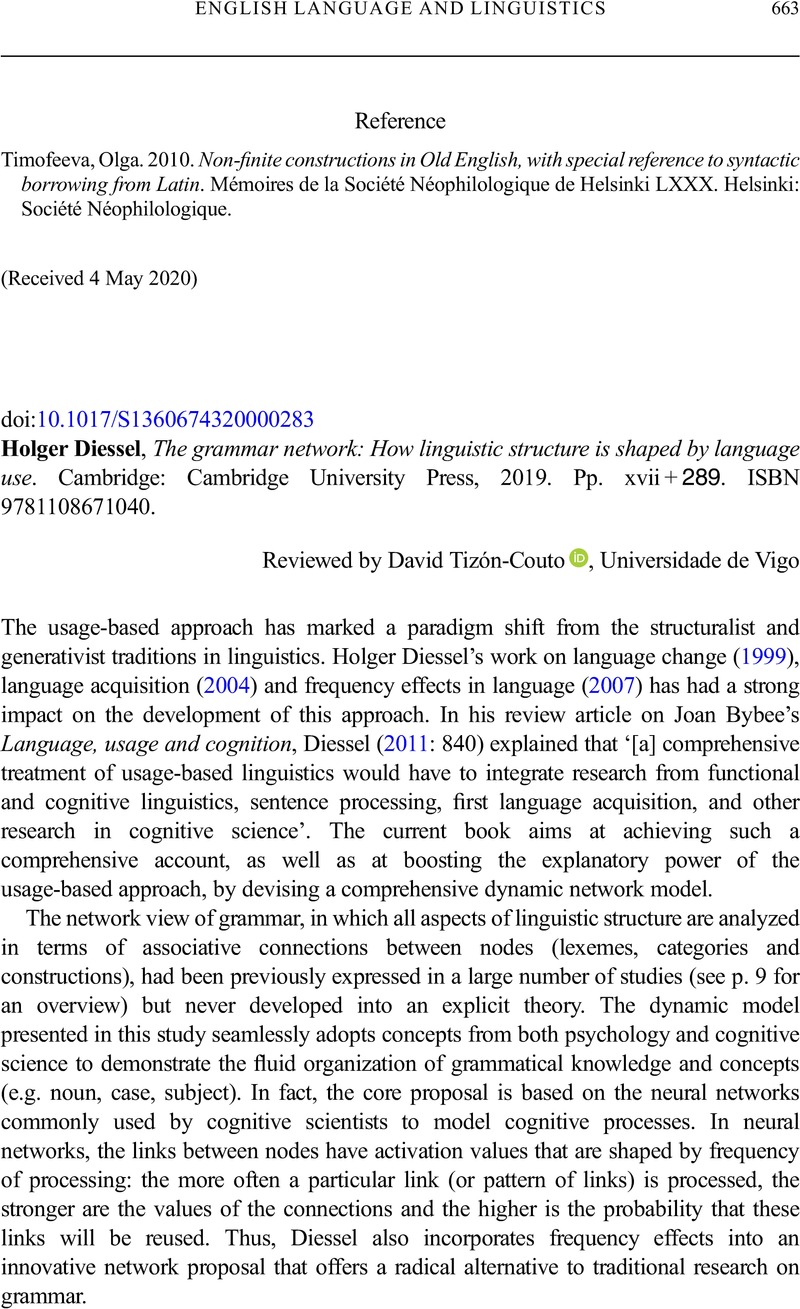No CrossRef data available.
Article contents
Holger Diessel, The grammar network: How linguistic structure is shaped by language use. Cambridge: Cambridge University Press, 2019. Pp. xvii + 289. ISBN 9781108671040.
Review products
Holger Diessel, The grammar network: How linguistic structure is shaped by language use. Cambridge: Cambridge University Press, 2019. Pp. xvii + 289. ISBN 9781108671040.
Published online by Cambridge University Press: 05 August 2020
Abstract
An abstract is not available for this content so a preview has been provided. Please use the Get access link above for information on how to access this content.

- Type
- Book Review
- Information
- English Language & Linguistics , Volume 25 , Special Issue 3: Spoken language in time and across time , September 2021 , pp. 663 - 671
- Copyright
- Copyright © The Author(s), 2020. Published by Cambridge University Press
References
Arnon, Inbal & Snider, Neal. 2010. More than words: Frequency effects for multi-word phrases. Journal of Memory and Language 62, 67–82.CrossRefGoogle Scholar
Blumenthal-Dramé, Alice. 2012. Entrenchment in usage-based theories: What corpus data do and do not reveal about the mind. Berlin: De Gruyter Mouton.CrossRefGoogle Scholar
Bürki, Audrey, F. Alario, Xavier & Frauenfelder, Ulrich H.. 2011. Lexical representation of phonological variants: Evidence from pseudohomophone effects in different regiolects. Journal of Memory and Language 64, 424–42.CrossRefGoogle Scholar
Bybee, Joan. 2010. Language, usage and cognition. Cambridge: Cambridge University Press.CrossRefGoogle Scholar
Diessel, Holger. 1999. Demonstratives: Form, function, and grammaticalization. Amsterdam: John Benjamins.CrossRefGoogle Scholar
Diessel, Holger. 2004. The acquisition of complex sentences. Cambridge: Cambridge University Press.CrossRefGoogle Scholar
Diessel, Holger. 2007. Frequency effects in language acquisition, language use, and diachronic change. New Ideas in Psychology 25, 108–27.CrossRefGoogle Scholar
Diessel, Holger. 2011. Review article on Language, usage and cognition by Joan Bybee. Language 87, 830–44.CrossRefGoogle Scholar
Divjak, Dagmar & Caldwell-Harris, Catherine L.. 2015. Frequency and entrenchment. In Dąbrowska, Ewa & Divjak, Dagmar (eds.), Handbook of cognitive linguistics, 53–75. Berlin: De Gruyter Mouton.CrossRefGoogle Scholar
Fillmore, Charles J. 1982. Frame semantics. In Geeraerts, Dirk (ed.), Cognitive linguistics: Basic readings, 373–400. Berlin: Mouton de Gruyter.Google Scholar
Goldberg, Adele E. 2006. Constructions at work: The nature of generalization in language. Oxford: Oxford University Press.Google Scholar
Hartsuiker, Robert J. & Moors, Agnes. 2018. On the automaticity of language processing. In Schmid (ed.), 201–26.Google Scholar
Langacker, Ronald W. 2000. A dynamic usage-based model. In Barlow, Michael & Kemmer, Suzanne (eds.), Usage based models of language, 1–63. Stanford, CA: CSLI Publications.Google Scholar
Lorenz, David & Tizón-Couto, David. 2019. Chunking or predicting – frequency information and reduction in the perception of multi-word sequences. Cognitive Linguistics 30(4), 751–84.CrossRefGoogle Scholar
Schmid, Hans-Jörg (ed.). 2018. Entrenchment and the psychology of language learning. Berlin: De Gruyter Mouton.Google Scholar
Schönefeld, Doris (ed.). 2011. Converging evidence: Methodological and theoretical issues for linguistic research. Amsterdam: John Benjamins.CrossRefGoogle Scholar



